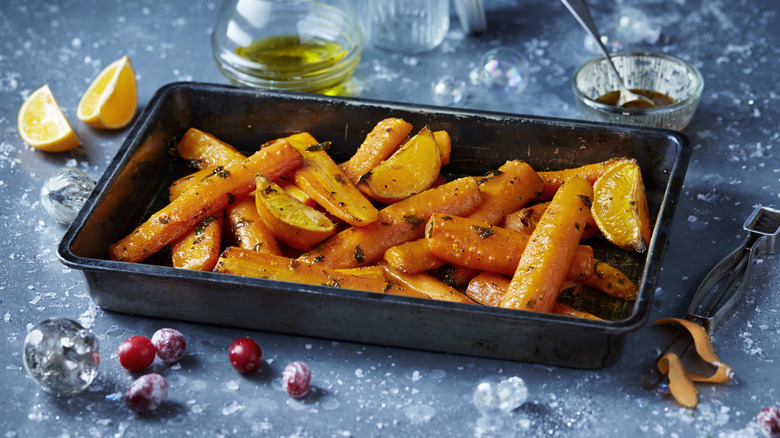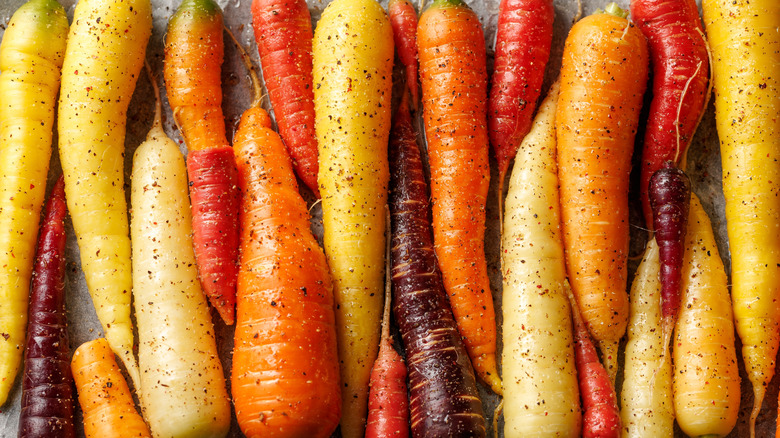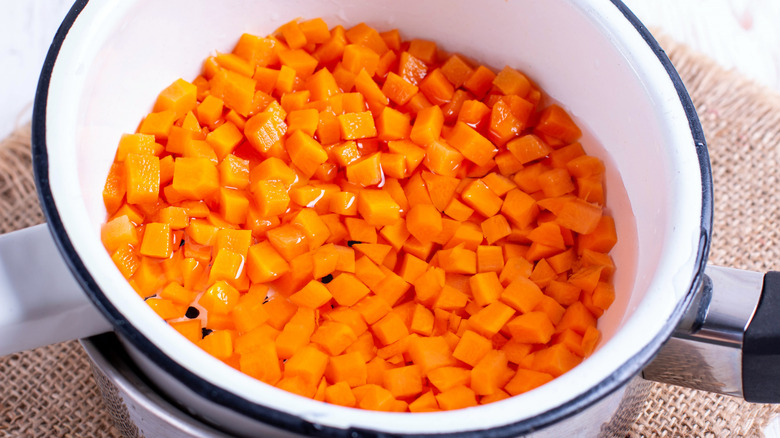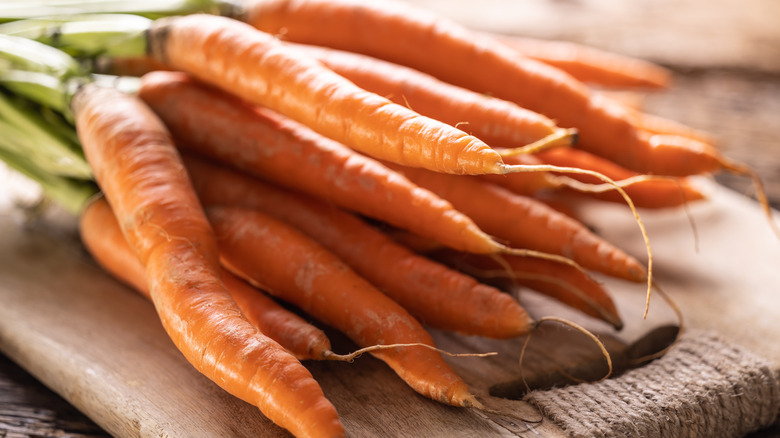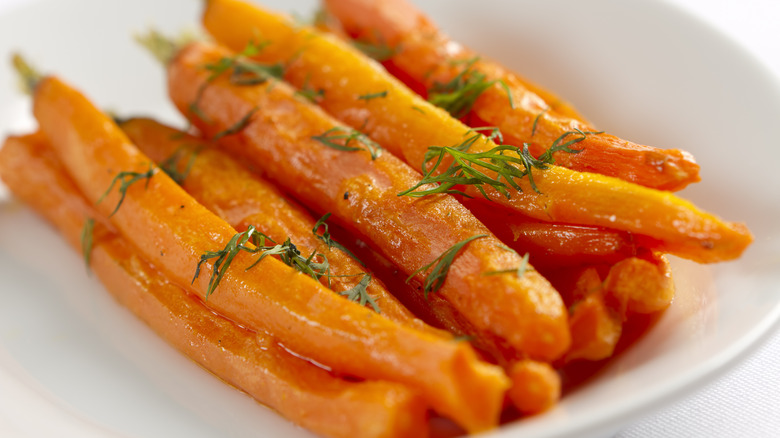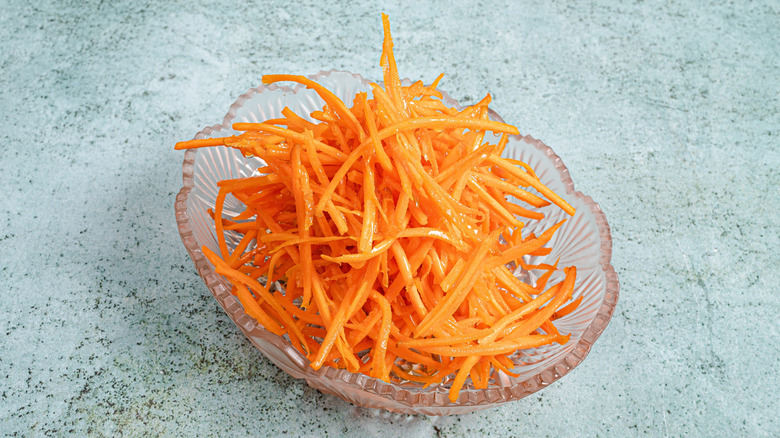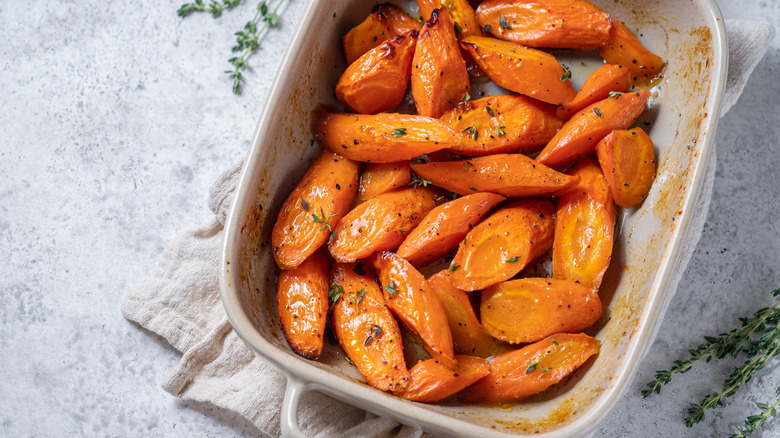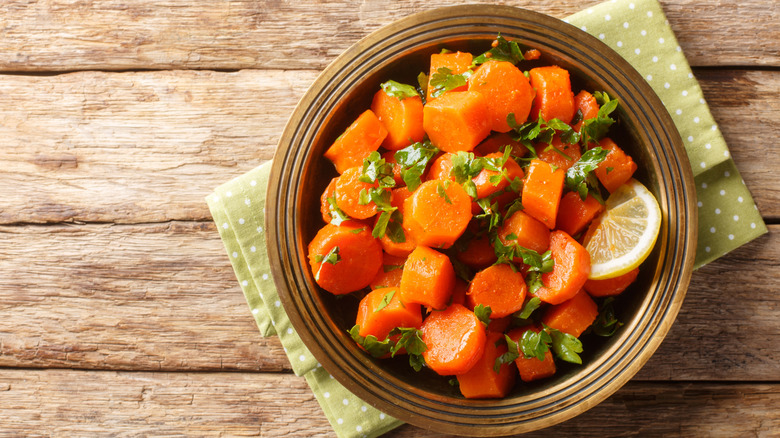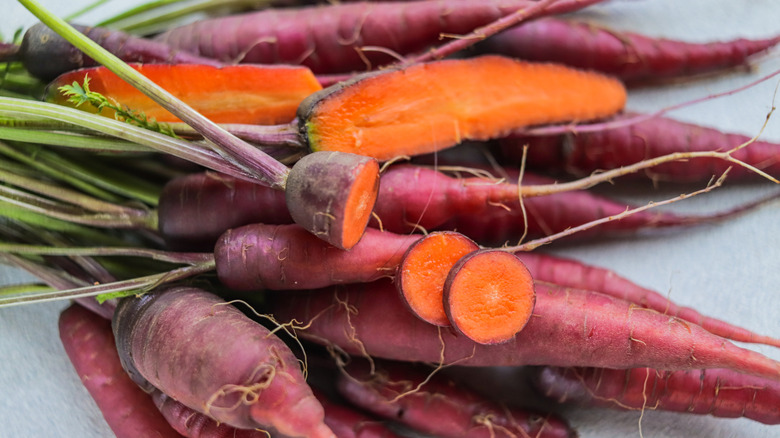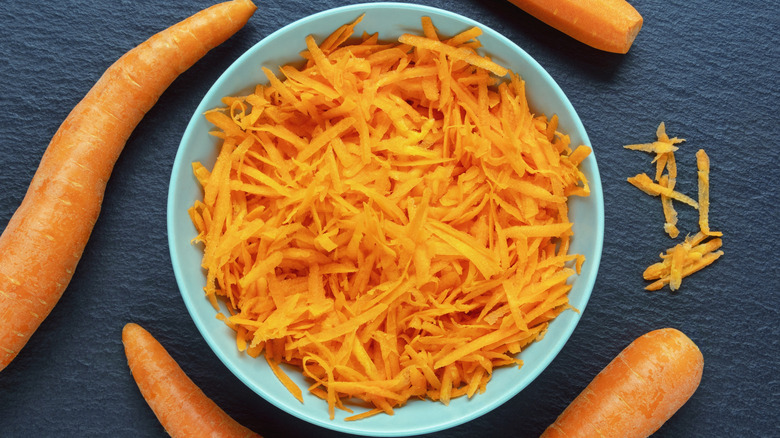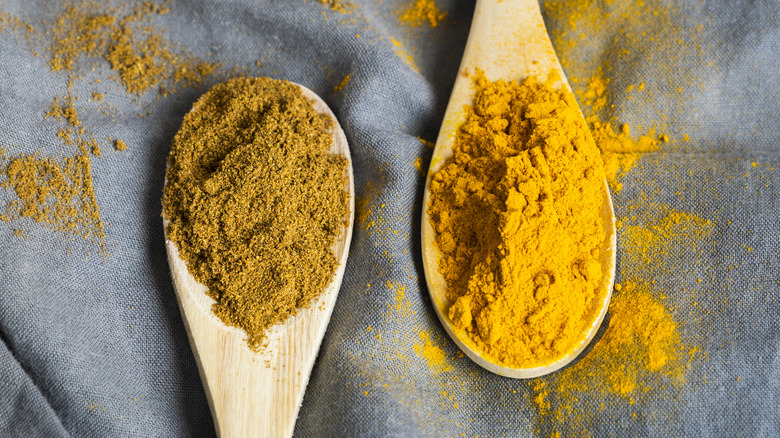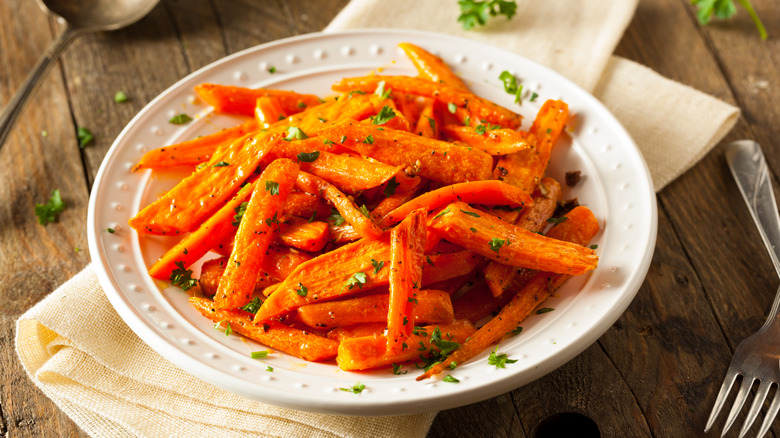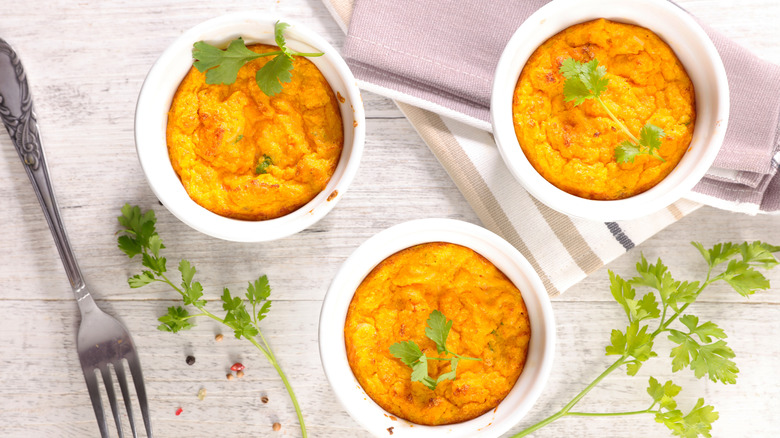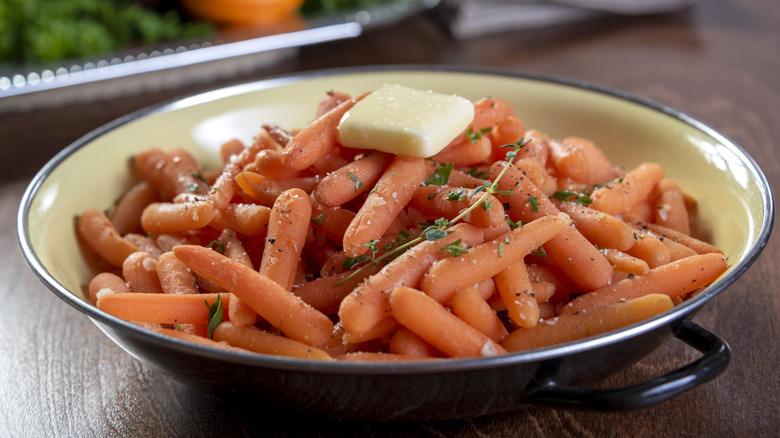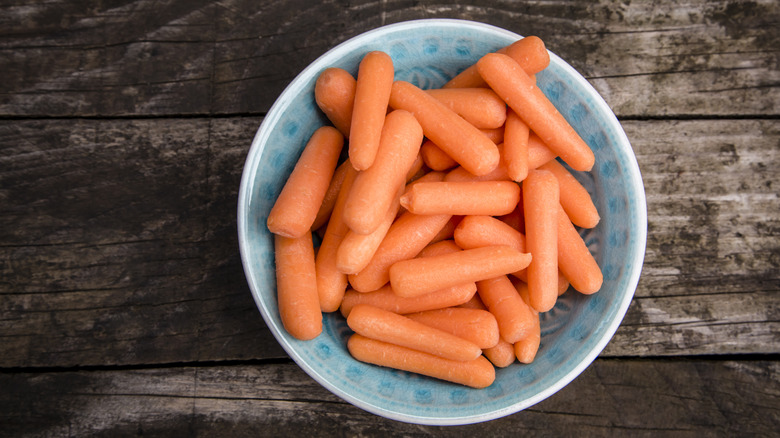14 Common Mistakes Everyone Makes When Cooking Carrots
Made some carrots recently? We're willing to bet that you might not have cooked them to their true potential. Carrots are criminally neglected in the kitchen, and you're likely making a few key mistakes that everyone does with these delicious veggies. Carrots are not to be underestimated: Not only are they astoundingly healthy and full of vitamin A and beta carotene, but they also have a deliciously sweet and earthy flavor that lends them to both savory and sweet dishes. Their crunchy texture yields when cooked well, into a soft, tender bite that rivals potatoes and parsnips. Yet, all too often they're sliced up messily, over-boiled, and left to wilt on the side of your plate as an afterthought.
Well, not anymore. We're here to put a stop to all of those key mistakes that people make when cooking carrots. From always using the same variety in your recipes, to failing to add key ingredients that can make them sing, to slicing and preparing them incorrectly (which can have a big impact on their flavor), there's a litany of errors out there. Let's stop them, right here, right now.
1. Mistake: Forgetting about the different varieties available
A carrot's a carrot, right? Not quite. Just like any other root vegetable, there are many different types of carrots out there — and one thing that people tend to do when cooking them is to forget that each variety has its own flavor, shape, and use. Your regular orange carrots are usually one of four different varieties: Imperator, Danvers, Nantes, or Chantenay. It's slightly harder to tell these apart, but it's worth noting that each of them has slight differences when it comes to how they taste. Chantenay carrots, for example, have a fresh, juicy snap and may be better for using raw, whereas the sweetness of Nantes carrots makes them ideal for juicing or roasting to unlock even more flavor.
Where things get really funky is with different-colored carrots. Purple carrots have a spiciness to them that deepens their flavor slightly, and makes them excellent in salads or used in a crudité dish. Conversely, white carrots have a mild and sweet flavor, and with their color, they make a great substitute for potatoes or parsnips in stews or soups. If you want your dish to have visual flair, use a combination of different colors to bring things to life.
2. Mistake: Over-blanching your carrots
Blanching carrots has several purposes. If you're freezing them, it helps to deactivate enzymes that can damage your carrots' quality after they've been plunged to a sub-zero temperature, helping to keep them crisp and tasty instead of turning to mush. Blanching carrots also helps them cook more evenly if you're roasting or baking them, beginning the process so that they cook all the way through.
When it comes to blanching, though, it's very easy to overdo it — and a lot of people end up boiling their carrots instead. Keeping your carrots in hot water for even a minute too long will cause them to break down, making freezing or cooking them further very difficult. The best way to avoid over-blanching your carrots is to keep an eye both on the time and the carrots' shape. Make sure you're slicing them into evenly-sized pieces, so that you're not tempted to keep them in the hot water for a little longer so that the larger chunks cook. If you've sliced, diced, or batoned your carrots, they'll only need around three minutes. Larger pieces will need a minute or two longer, but not much more time. Finally, once you've finished blanching them, ensure that your ice bath is close by so you can plunge them into cold water, stopping the cooking process.
3. Mistake: Cooking with carrots you've stored incorrectly
Like most root vegetables, carrots are incredibly robust and can remain crisp and firm for a number of weeks after buying them. However, that's totally dependent on how you store them — and if you've done so incorrectly, you're not going to have a good time. When carrots are stored poorly, they go limp and floppy, losing all of their snap. If you then try and cook with them, they won't magically regain their firmness: Instead, you'll just end up with disappointingly soft, mushy carrots.
The solution? Nail your storage game. The best way to keep your carrots fresh is by popping them in an airtight container full of water that you keep in your fridge. By keeping the carrots well-soaked and away from the circulating air of the refrigerator, you'll stop them from drying out, which can be a key cause of them becoming floppy. Ensure that you don't peel them before doing this, as their skin is part of what keeps them firm. It can also be a good idea to get rid of any greens attached to the end of the carrot, as these can contribute to the carrot wilting.
4. Mistake: Thinking that boiling your carrots is the only option
Boiled carrots are synonymous with depressing TV dinners, bad airplane food, and boring, drab midweek meals. Despite this, a lot of people think that if you're cooking carrots, then boiling them is the way to go. This couldn't be further from the truth. There are countless recipes that celebrate carrots which don't involve boiling them at all, and instead focus on roasting, baking, glazing, or sautéeing them, all of which give them way more flavor.
Using a dry heat method to cook carrots allows you to take advantage of their natural sugars, which help the veggies brown and caramelize slightly. This turns their bright, sweet flavor into something more mellow and rich. Dry heat cooking, as well as sautéeing, also allows you to experiment with flavors. You can also throw carrots on the grill to give them a deep sear, eat them as is, or throw in some extra flavors to make Not Dogs, a hot dog substitute that your friends will be trying to emulate for years to come.
5. Mistake: Slicing them the same way every time
If you're bored of carrots, it may not be because of how the vegetable tastes. The way that you prepare any vegetable can have a significant effect on how much you enjoy it, and if you're slicing your carrots the same way every time, you're not harnessing their true potential. Carrots' sturdy texture and long shape make them well-suited to a range of basic knife cuts that you can use to make them way more appealing and versatile.
It all starts with batons. By learning how to baton your carrots, you not only turn them into a shape that works well in dishes like tacos or carrot fries, but you can then make subsequent knife cuts that open up more opportunities. Turn your batons into julienned carrots, and you have elegant slices of the vegetable that can work as a garnish, in coleslaw, or as a cool, crisp side dish. Slicing your julienned carrots crossways will turn them into tiny chunks (this is known as brunoise, for all you culinary nerds out there) that slot perfectly into minestrone soups or fried rice dishes. These knife cuts don't just give your carrots visual flair, but will also stop you from having massive chunks of carrot in every bite of your meal.
6. Mistake: Forgetting to add sweet ingredients to your carrots
Carrots are delightfully malleable vegetables, and can have inherent sweet notes that give them a slightly sugary taste. This makes them perfectly suited to be used with sweet ingredients — and yet, so many people forget to do so. We're not talking about applications that explicitly use carrots in sweet recipes here, like carrot cake. Instead, we're talking about when you're serving carrots as a side dish or as part of a main meal. By adding sweet ingredients to use alongside savory ones, you create a sweet-salty dynamic that allows your carrots to explode with flavor.
Tossing your carrots in a little honey before roasting them not only helps them brown, but develops their natural sweetness into a deep, textured flavor. When this deep sweetness is paired with the earthiness of the carrots, things get pretty complex and juicy — and when this is all balanced with a sprinkling of flaky sea salt, you create a side dish that you won't be able to get enough of. If you don't have honey, never fear: Maple syrup, golden syrup, and even molasses can supply carrots with similar sweet notes.
7. Mistake: Undercooking your carrots
One mistake that's almost as bad as forgetting how to cook carrots is not cooking them enough — and it's something that a lot of people do. Undercooking carrots won't stop them from being edible, of course, but it does stop them from being as good as they can be. The joy of a cooked carrot is biting into its squashy texture, and feeling its inside yield between your teeth. If that inside is still chalky and hard, well, it's just not going to hit the spot. Nor will its flavor be as rich and developed as it can be.
It's surprisingly easy to miss that your carrots are undercooked, too. Carrots often look finished way before they are. Plus, if you're checking them by plunging a sharp knife or fork tongs into a piece, then that very sharpness may allow them to move through the core more easily than normal. Instead, we recommend using a semi-blunt knife (like a butter knife) to check whether your carrots are cooked through. If it passes through with no resistance, then you know that you're ready to go. If it's tough to push it through the vegetable, give it another few minutes.
8. Mistake: Failing to remove the core
When you prepare carrots, what do you do? You probably just peel them, slice them, and then you're good to go, right? Well, if you're dealing with larger carrots, there's one other thing you should definitely be doing: Removing their core. People tend to leave the carrot's core in place when cutting their carrots into batons or julienne sticks because it can feel like you lose way too much of the vegetable. The truth, though, is that in larger carrots the core can be pretty bitter, and leaving it in can ruin the flavor of your final dish.
It's also worth bearing in mind that carrot cores aren't that good for you. The vitamins in carrots are mostly in the orange flesh, as opposed to the core itself. While the core does provide a boost of fiber, if it's ruining the taste of your dish it's not worth it. It's also useful to remove the core if you're puréeing your carrots to use in a soup, so that you get all of that delicious sweet flavor without any bitterness clouding the taste.
9. Mistake: Forgetting that the way you prepare your carrots will affect their flavor
So, here's the deal with carrots. The way you prepare them can change the way they taste. If you're grating your carrots, you might find that they have a boost of sweetness. This is all rooted in a very scientific reason, according to "Milk Street" author and founder of "America's Test Kitchen" Christopher Kimball. Speaking to Rachael Ray, Kimball detailed what he explains in "Milk Street," which is that grating carrots breaks down their cell walls. This amps up their sweetness, giving them a sugary flavor that you won't find otherwise.
It's also worth remembering that grating carrots won't just give them more flavor, but will in turn allow them to become way more flavorful. When you shred carrots, you give them a coarser texture. This means that they're more receptive to any seasonings that you're putting on them, and retain additional flavors more strongly. It's the main reason why dressing works so well on shredded carrots, as the dressing is able to work its way into the bumps and rivulets left by the grater.
10. Mistake: Using the same seasonings every time
It's very easy to make your carrots boring, and one of the main ways that people do this is by playing it safe with their seasonings. However, while salt and pepper may be a solid option, they're far from the only thing you can put on carrots. These veggies are astonishingly capable of taking on almost any seasoning blend or spice, and with very few flavor clashes out there, you can be sure that no matter what you throw on your carrots, they'll likely come out well.
If you want to fully lean into fall flavors, try making cinnamon roasted carrots. The spicy warmth of the cinnamon pairs gorgeously with the earthy sweetness of the carrots, which is reinforced by honey and orange juice for a dynamic dish. Alternatively, curry roasted carrots amp up their complexity with curry spices and bring in some much-needed heat with hot red pepper sauce. You don't just have to use dry seasonings, either: Dousing your carrots in soy and oyster sauce can give them a serious whack of umami, which nicely complements their sugary notes. Don't be afraid to experiment with your seasonings — your new favorite combo might be just around the corner.
11. Mistake: Overcrowding your pan when roasting your carrots
To roast carrots properly, you need to give them space — something that a lot of people just don't understand. Instead, they throw all of their carrots into a tiny roasting dish, and then expect them all to come out browned, beautiful, and bursting with flavor. Instead, they're disappointed when they pull the dish out of the oven and find that their carrots are mushy and swimming in water, with any seasonings that you put on them having long dripped off into the soup below.
This happens because when you overcrowd your pan, the oven's heat can't circulate around each vegetable properly. This simultaneously stops them from browning properly and also causes them to steam, turning them soft. This won't just happen if they're shoved up against each other, either — it'll also occur if you double-stack your carrots. Luckily, avoiding this is simple. Make sure your roasting dish is big enough for your carrots, and ensure that you don't place them too close to one another or in more than one layer. If you must, just use two roasting dishes or cook your carrots in batches.
12. Mistake: Not being adventurous with your sweet carrot recipes
If you think of how to use carrots in sweet recipes, you probably immediately think of carrot cake, right? Hey, no judgment — carrot cake is absolutely delicious, and we'd happily eat it every day of the week. By just assuming that you can only use carrots in carrot cake, though, you miss out on the other opportunities to enjoy this vegetable in dessert form. There are lots of ways to harness the innate sugariness and orange pop of carrots in various desserts, and carrot cake's just the tip of the iceberg.
One of our favorite (and most adventurous) sweet carrot recipes is carrot soufflé. This dish takes puréed carrots and combines them with sugar, eggs, vanilla, and flour, before baking it all in a dish until the soufflé rises. When it comes out of the oven, the soufflé should be gently caramelized on top, with a gently nutty flavor. Alternatively, turn your regular carrot cake into cookies, making a snack that harnesses the flavor of the cake in transportable, crumbly form. You can even candy your carrots, simmering them in a sugar mixture to make a moreish sweet treat.
13. Mistake: Glazing your carrots incorrectly
Glazing carrots is one of the most delicious ways to prepare them. You begin by simmering your carrots in water, before coating them with a mixture of butter, sugar, salt, and pepper, to make a sweet-spicy side dish that pairs perfectly with your Thanksgiving dinner. One key mistake people make when glazing carrots, though, is adding too much water to the pan. These carrots aren't meant to be submerged in water and boiled, but rather gently cooked through using a combo of a little water and steam. This method keeps them somewhat firm while softening them enough to take on the flavors of the glaze.
When glazing, you need a maximum of an inch of water for every 2 pounds of carrots. Don't be tempted to add more: Instead, cover the carrots to keep the steam in, and turn down the heat. Remember, too, that you don't have to just use water in this process. You can also glaze your carrots in orange juice (thank us later, folks). This gives your carrots way more flavor, and boosts the sugary notes that are then brought home by the butter-sugar mixture.
14. Mistake: Forgetting about baby carrots
We should never forget about the little guys in our lives — and that goes for carrots as much as it does humans. Way too many people neglect baby carrots for their chunkier, longer parents, but the truth is that there are lots of applications where baby carrots are way preferable. They're ideal for serving to kids, sure, but they're also ideal for throwing into stews and casseroles. They're also great for making roasted carrot dished, as you have to do very little preparation. Plus, roasting them will help bring out some of the sweetness that raw baby carrots can sometimes lack, as they haven't had the chance to develop natural sugars as much as larger carrots have.
You can also use baby carrots to make a carrot cake, but if you're doing so, you may have your work cut out. Carrot cake requires you to break down your carrots by grating them, and grating baby carrots can be a lot of work. We'd recommend using a food processor to make your life easier.
